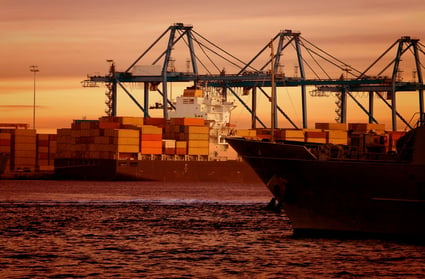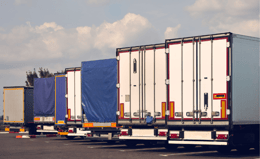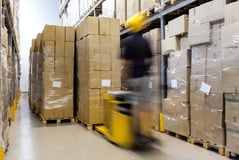What Is the Future of Freight?
Brian Hoey - December 24, 2020

 When it comes to the way that goods are moved across the globe, the recent pandemic has acted as more of an accelerant than anything else. With the coming rise of Industry 4.0 and Logistics 4.0 systems for smarter supply chain management, businesses were already seeking to leverage digitization, cloud technology, and AI towards more resilient planning. Now, that resilience has become non-negotiable—and shippers, freight forwarders, and manufacturers need to get ready to embrace the future of freight.
When it comes to the way that goods are moved across the globe, the recent pandemic has acted as more of an accelerant than anything else. With the coming rise of Industry 4.0 and Logistics 4.0 systems for smarter supply chain management, businesses were already seeking to leverage digitization, cloud technology, and AI towards more resilient planning. Now, that resilience has become non-negotiable—and shippers, freight forwarders, and manufacturers need to get ready to embrace the future of freight.
Obviously, this puts pressure on most organizations, but it also presents opportunities for growth and improvement. The global supply chain has been getting at once more fragmented and more connected for decades. By embracing both the value of connectivity and the reality of fragmentation, many businesses have made their supply chains more robust and resilient. In this way, they’re helping to power a future in which freight is increasingly digitized and thus increasingly resistant to disruption.
Integrated Supply Chain Planning
Among other things, the pandemic has shown how interconnected the global value chain already is—with single-sourced suppliers in far-flung locales bringing complex value chains to a complete halt overnight. For manufacturers, success already depends on getting increasing visibility into your upstream partners’ value chains, and as freight evolves it will be more common to see technological integration with one’s shipping partners as well. Why? Because as competition for limited freight capacity gets stronger, manufacturers will have to lengthen their transportation planning windows, which will require robust forecasting based on highly-visible data.
Over time, this level of integration can and should lead to point a where holistic, comprehensive planning flows cover the entire operation of the supply chain—rather than merely existing in silos that are divided by corporate divisions and planning horizons (i.e. strategic, tactical, and operational planning all treated as separate). Instead of a manufacturers generating production plans within their own walls and then scrambling to leverage those plans into executable transport runs, collaborative, real-time, integrated planning processes would enable them to forecast customer demand and work together with suppliers and shipping partners to get the right raw materials and finished goods to the right place, at the right time, at the right cost.
This paradigm only works with full supply chain visibility—and with resilient supply chain plans that can be adapted in real-time to changing conditions. Again, freight capacity is harder to secure than ever, which means that in the future logistics providers could show a preference for true supply chain partners. The implication here is that players across various supply chain touchpoints will need the infrastructure to instantaneously collect and share data and then leverage that data into adaptive plans that can be executed up and down the chain. Logistics providers will have to be proactive in their route and tour planning, while being able to react quickly as needed—which means that manufacturers will have to be able to do the same in order to keep up.
Going Green
As freight increasingly requires digital infrastructure—from cloud applications and IoT devices to shared technology platforms integrated with smart ports—in order to thrive, manufacturers will need to prioritize IT integration and holistic planning in order to stay plugged in. As all this is going on, however, there will be another important question on logistics providers minds: how can we best comply with new and upcoming environmental regulations with an eye towards transitioning to a more sustainable way of transporting goods in the long term? As the world steps up it efforts to deal with climate change, enterprises across the supply chain spectrum will need to be able to accurately track their carbon emissions on an ongoing basis. Thus, shippers and freight forwarders will need to adopt planning solutions that enable them to set emissions parameters among their other constraints in order to weigh them against costs, on-time expectations, etc.
Like the comprehensive, integrated planning we discussed above, tracking the environmental impact of your logistics networks requires a high degree of visibility. Once you have that visibility, you can train AI- and machine learning-powered algorithms on your emissions data to identify potentially more sustainable ways to administer your network and help you visualize the cost and time tradeoffs that might arise in particular planning horizons with regard to emissions. At the same time, new advances in electric vehicles and other sustainable technologies will change the calculus even further. A freight provider might, for instance, have to weigh the capital commitments that come with upgrading parts of an existing fleet to electric vehicles against the carbon expenditures that come from planned routes with the existing fleet on various time horizons. In order to perform these calculations successfully, they’ll need accurate demand and price forecasts, as well as well as dynamic, data-driven planning capabilities.
Building a Digital Foundation
In the increasingly digital world we’ve been describing, freight forwarders, logistics providers, and manufacturers alike are going to need to put their digital transformations into high gear. Why? Because the integrated planning paradigm shift that we’re discussing requires a strong digital backbone based on:
- Cloud platforms with the power to scale easily and increase connectivity
- Digital twins that can offer smart supply chain simulations
- AI and machine learning solutions designed around improving forecasts and empowering real-time decision-making.
- Integrated planning environments that connect tactical, strategic, and operational planning into a unified model
These items form the basic underlying elements that will help usher in the future of freight. As a manufacturer, your ability to stay competitive in a global supply chain is going to rest on your ability to adopt these elements in order to better integrate with your logistics partners. This may sound like an onerous requirement, but in point of fact these improvements will add value in myriad other ways—not the least of which will be improved forecasts that enable you to reduce your capital commitments. For years, there’s been a sharp dichotomy between build-to-order and build-to-stock manufacturing strategies; smarter, more connected real-time technology can put you in a position to break down that dichotomy and achieve an optimal production strategy—and the connected freight landscape of the future will help you get there.
LATEST POSTS
- Understand Circular Economy in The Manufacturing Industry
- How Can Industry 4.0 IT Integration Be Achieved Smoothly?
- The Significance of Order Sequencing in Discrete Manufacturing
- How to improve your Supply Chain Management: The Power of Control Towers
- Optimizing Human Resource Scheduling in Manufacturing: A Technological Approach



